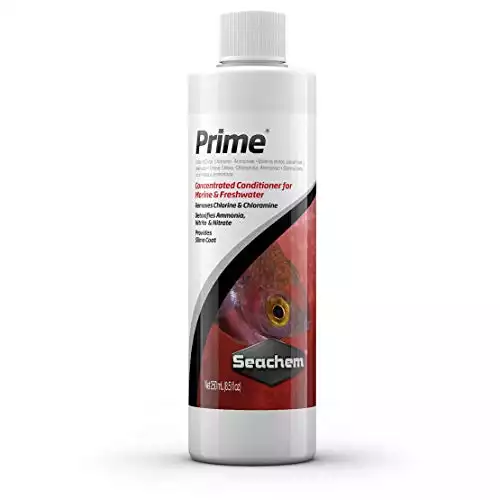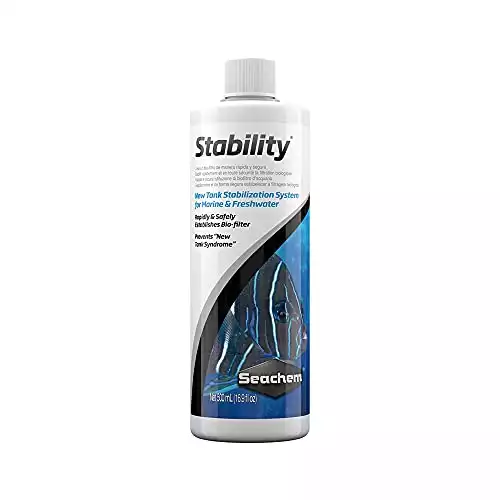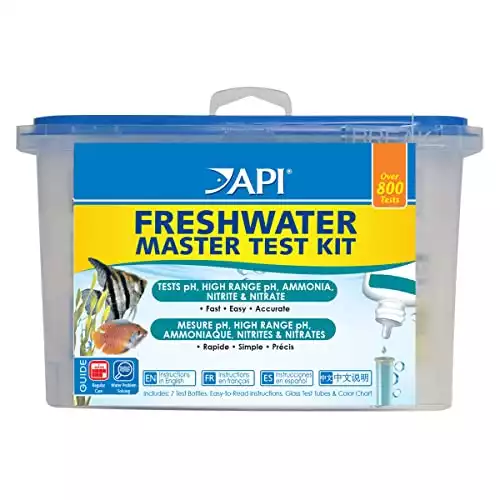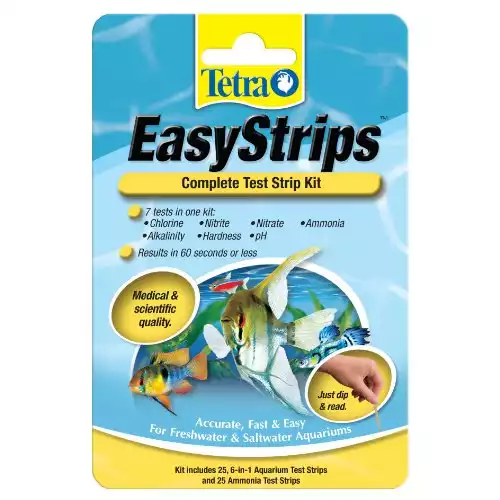
Read on to find out the best ways of cycling a fish tank successfully, and get some top tips to help you along the way.
- Is Cycling A Fish Tank Necessary?
- How Long Does It Take To Cycle A Fish Tank?
- First Things First
- 1. How To Cycle A Fish Tank Quickly With An Established Filter
- 2. How To Cycle A Fish Tank With Plants
- 3. How To Cycle A Fish Tank Without Fish / Fishless Cycle
- 4. How To Cycle A Fish Tank With Fish / Fish In Cycle
- New Tank Syndrome – My New Fish Are Dying!
- How Do I Know When My Fish Tank Is Cycled?
- Now You Know How To Cycle A Fish Tank…
Is Cycling A Fish Tank Necessary?
Yes, cycling a fish tank is an essential part of this hobby. Unless you want your fish to be belly up after 2 weeks due to new tank syndrome, it’s something you’re going to have to do.
The term ‘cycling a fish tank’ refers to the nitrogen cycle. This is where you have to establish enough beneficial bacteria within the aquarium to deal with the waste produced by your fish.
There are a few different ways you can cycle a fish tank, the most common ways are, using an established filter (aka seeding an aquarium), cycling with plants, a fishless cycle, and a fish-in cycle.
Unknowledgeable fish stores will say, “Set your tank up (no fish), leave it running for 30 days, and then your tank will be cycled and ready for your fish”. If you go to a fish store that says this, run for the hills and don’t go back, as it is complete garbage!
This will not cycle the tank one bit, and your fish will more than likely be belly up within a couple of weeks of adding them to your tank.
How Long Does It Take To Cycle A Fish Tank?

Generally, it takes around 2-8 weeks to cycle a fish tank, depending on the method you use. Water temperature and pH levels also affect how long it will take.
Beneficial bacteria thrive and multiply best at a pH level of around 7.0-8.0. If the pH drops below 6.2, this will stall the bacteria from multiplying and stop the cycling process.
To raise the pH, perform a partial water change and/or add some crushed coral to your tank.
Raising the water temperature will also allow the beneficial bacteria to multiply faster and speed up the cycling process. The optimum temperature range is around 80°F-86°F.
First Things First
The first thing you need to do regardless of which cycling method you are going to use is to set your tank up.
Add the substrate, decor, and water. Dechlorinate the water, my go-to product for this is Seachem Prime) and set the filter and heater running.
Seachem Prime is an essential item for ALL fishkeepers!
It removes chlorine and chloramine from tap water.
It detoxifies ammonia, nitrite & nitrate, making the aquarium water safe for your fish.
Directions: Add 5 ml per 50 gallons (200 liters) for regular detoxification.
Up to 5 times the dose (25 ml per 50 gallons) can be used in an emergency if ammonia or nitrites exceed 2 ppm.
- Easy to use
- Removes chlorine & chloramine
- Detoxifies ammonia, nitrite & nitrate
- Doesn't expire (if stored correctly)
- Suitable for fresh & saltwater aquariums
- Strong sulphur smell
1. How To Cycle A Fish Tank Quickly With An Established Filter

Also known as seeding an aquarium, this is the best and easiest method and how to cycle a fish tank fast!
If you already have an established (cycled) tank, use some of the filter media from your established tank (the gunkier the better!) and add it to the new tank or you could add a sponge filter to your established tank for a minimum of 4 weeks to allow the beneficial bacteria to colonize it, then transfer it to the new tank.
You can also use substrate, decor, or plants from an established tank, but filter media has the most bacteria so works the best.
If you don’t have an already established tank, see if you can take some filter media from a buddy’s tank, or if you have a trusted local fish store, they may give you some filter media to use.
I don’t recommend asking large chain pet stores for any of their media, as they are notorious for having disease outbreaks, such as freshwater ich which you do not want to introduce to your new tank.
This method is how to cycle a fish tank instantly, but don’t get carried away and chuck lots of fish in straight away!
Introduce 1-2 fish at first, then wait a couple of weeks before adding more fish. This gives the beneficial bacteria time to become established in the tank.
If you add lots of fish straight away, they will produce too much waste for your nitrifying (beneficial) bacteria to cope with and you’ll end up crashing your cycle.
Test the water daily after adding your fish, to make sure there are enough nitrifying bacteria to get rid of the waste produced by the fish.
Optional – Dose with Seachem Stability when you add the fish, this will ensure you have enough nitrifying bacteria in your tank to process any waste that your fish will produce.
Seachem Stability is a must for new fishkeepers, to prevent 'new tank syndrome' or for when you've added too many new fish and the nitrogen cycle can't cope.
It helps to establish beneficial bacteria in your aquarium, which is essential for your fish's health and survival.
Directions: Shake well before use and turn off the UV filter (if you have one).
Use 1 capful (5 ml) for every 10 gallons (40 liters) on the first day with a new aquarium. Then use 1 capful (5 ml) for every 20 gallons (80 liters) daily for 7 consecutive days.
- Easy to use
- Prevents new tank syndrome
- Can be used in fresh & saltwater aquariums
- None!
2. How To Cycle A Fish Tank With Plants

Cycling an aquarium with live plants is another great choice and it is how nature deals with toxins in rivers and streams etc.
This may not be the best method for you if the fish you want to keep will eat the plants!
Add plenty of plants to your aquarium, fast-growing plants like water sprite are a good choice, as they will consume lots of ammonia, nitrite, and nitrate from the water.
Make sure you keep the plants fertilized with something like API Leaf Zone as there are no nutrients in the water for them to feed off.
Give the plants around 6-8 hours of lighting per day.
When you see a lot of new growth on the plants or algae starting to grow, this means the plants are consuming any ammonia, nitrites, or nitrates in the water enabling them to grow.
Wait around 4 weeks before adding fish just to be sure the tank is ready for your fish.
Once you do start adding fish, only add 1 -2 at a time, don’t overfeed them, and keep testing the water to make sure the plants can handle the waste produced by your fish.
One tip to speed this process up, if you have an established tank, or have a friend with one, you could take a plant from that tank as it’ll already have beneficial bacteria growing on it, thus giving the cycling process a kick start.
3. How To Cycle A Fish Tank Without Fish / Fishless Cycle

A fishless cycle is when beneficial bacteria grow and become established in the tank, making it safe before you add your fish.
Introduce Ammonia (Toxic To Fish)
By either adding small amounts of fish food daily (the fish food will eventually rot causing ammonia levels to rise) or the quicker and easier method is to add Fritz Fishless Fuel to kickstart the cycling process.
Use a test kit to check the ammonia levels and keep a log of them.
The ammonia levels in your tank will spike and then begin to drop, this lets you know that the beneficial bacteria called Nitrosomonas is present and is consuming the ammonia.
Nitrite (Toxic To Fish)
The beneficial bacteria that consume ammonia turn it into nitrite.
Keep testing the water, you will see your nitrite levels spike and then begin to drop.
Once this happens the second type of beneficial bacteria called Nitrobacter has formed and is consuming the nitrites, turning them into less harmful nitrates.
Nitrate (Safe At Low Levels For Fish)
Nitrates are the final step in cycling a fish tank and are much less toxic to fish at low levels.
Keep testing the water for a couple of days and make sure the ammonia and nitrite levels stay at 0ppm.
Tank Cycled
You have now successfully cycled your fish tank and it’s safe to add your fish (yay!).
It’s now your job to nurture the beneficial bacteria you have just lovingly grown and keep your nitrates at a safe level for the fish.
4. How To Cycle A Fish Tank With Fish / Fish In Cycle

This is an ‘old-school’ way of cycling a fish tank, but many still choose to use it.
I personally don’t use this method as it can cause unnecessary suffering to the fish, and why would you do that when there are other better cruelty-free options available listed above?
You can very quickly end up with a tank of dead fish on your hands if you’ve not researched this method thoroughly.
Here’s how to do a fish-in cycle as safely as possible, but be prepared that you may lose some fish!
Add 1-2 hardy fish per 10 gallons of water, if you add more than this they will produce too much waste, which will lead to new tank syndrome and potentially kill the fish.
Using a product like Seachem Stability (beneficial bacteria in a bottle) can help keep the water safe for your fish.
Feed the fish sparingly, every other day. What goes in must come out and the more waste there is the more toxins are produced, which may cause an ammonia spike.
You need to allow the beneficial bacteria time to colonize your aquarium…patience is key!
Test the water daily, checking for ammonia and nitrite (both are highly toxic to fish, even in small doses).
Whenever you see detectable levels of 0.2 ppm or above of ammonia or nitrite, do a partial water change (around 10%-20%) to lower the levels of these toxins. Ensure you treat the new water you are adding back to your tank with a water conditioner, such as Seachem Prime.
Keep testing the water every 1-2 days and repeat the water-changing process when needed.
Once the levels of ammonia and nitrite are measuring 0 ppm and you are getting detectable levels of nitrates for a few consecutive days, this is a sign your aquarium is cycled and the nitrifying bacteria can convert the current level of waste.
Once your tank is cycled, add any new fish gradually, 1-2 at a time.
When you’ve added your new fish, test the water after a few days to check that the beneficial bacteria can cope with the additional waste.
New Tank Syndrome – My New Fish Are Dying!
So you went to the pet store and bought everything all at once, tank, substrate, filter, heater, water conditioner, water testing kit, and fish….rushed home to set it all up and it looked amazing, but then to your horror a few days later your new fish are gasping for air at the water’s surface, appear lethargic or are dying?
Chances are they are suffering from new tank syndrome and have ammonia poisoning. Ammonia is highly toxic to fish and essentially suffocates them.
You need to act quickly, here’s what to do and what not to do….
✅ Do dose the tank as quickly as possible with a water conditioner, my preferred choice is Seachem Prime, you can use 5 times the recommended dose if your ammonia or nitrite levels are high – 2 ppm.
Seachem Prime is an essential item for ALL fishkeepers!
It removes chlorine and chloramine from tap water.
It detoxifies ammonia, nitrite & nitrate, making the aquarium water safe for your fish.
Directions: Add 5 ml per 50 gallons (200 liters) for regular detoxification.
Up to 5 times the dose (25 ml per 50 gallons) can be used in an emergency if ammonia or nitrites exceed 2 ppm.
- Easy to use
- Removes chlorine & chloramine
- Detoxifies ammonia, nitrite & nitrate
- Doesn't expire (if stored correctly)
- Suitable for fresh & saltwater aquariums
- Strong sulphur smell
Prime removes chlorine & chloramine from tap water and detoxifies ammonia, nitrite & nitrate, making the aquarium water safe for your fish.
Please ensure you have good water flow and aeration in your tank as these products can reduce dissolved oxygen levels in the water.
✅ Do add a dose of Seachem Stability daily, it will help boost your beneficial bacteria quickly.
Seachem Stability is a must for new fishkeepers, to prevent 'new tank syndrome' or for when you've added too many new fish and the nitrogen cycle can't cope.
It helps to establish beneficial bacteria in your aquarium, which is essential for your fish's health and survival.
Directions: Shake well before use and turn off the UV filter (if you have one).
Use 1 capful (5 ml) for every 10 gallons (40 liters) on the first day with a new aquarium. Then use 1 capful (5 ml) for every 20 gallons (80 liters) daily for 7 consecutive days.
- Easy to use
- Prevents new tank syndrome
- Can be used in fresh & saltwater aquariums
- None!
The beneficial bacteria will grow naturally, so you don’t have to add this product, but it will speed up the recovery process.
✅ Do test the water daily after adding the water conditioner.
4.7 | 4.5 |
The API freshwater test kit offers outstanding value (over 800 tests!) and is very accurate, if you're serious about fishkeeping this is the best test kit to buy and the only one I use. | The Tetra test strips are quick & easy to use and measure all the vital water parameters that you need to monitor to keep your fish safe, but it can be difficult to read the colors, making them less accurate than the API water test kit. |
$13.49 | |
The API freshwater test kit offers outstanding value (over 800 tests!) and is very accurate, if you're serious about fishkeeping this is the best test kit to buy and the only one I use.
The Tetra test strips are quick & easy to use and measure all the vital water parameters that you need to monitor to keep your fish safe, but it can be difficult to read the colors, making them less accurate than the API water test kit.
If the ammonia, nitrite, and nitrate levels are still high or your fish appear lethargic and unwell, perform a 50% water change and treat the new water with the correct dosage of water conditioner.
✅ Do keep doing partial water changes (if needed) until the beneficial bacteria has had a chance to grow, you’ll need to test the water daily to establish this.
You need the ammonia and nitrite levels to be 0ppm and nitrate to be present, once you get these readings your tank is cycled.
✅ Do keep testing the water for ammonia, nitrite, and nitrate levels for a few more days, just to be sure the levels are staying stable and safe for your fish.
✅ Do reduce the amount you are feeding your fish, this will help reduce the ammonia levels as leftover rotting food and poop cause ammonia.
It won’t harm your fish to feed them every other day, whilst you get the ammonia and nitrite levels under control.
❌ Do not do a 100% water change, I know this sounds counterintuitive if the ammonia in the water is making your fish ill, but the beneficial nitrifying bacteria that you need to grow, need the ammonia to feed on.
It’s a balancing act of reducing or detoxifying the ammonia, whilst giving the nitrifying bacteria time to grow.
❌ Do not empty the tank completely and clean the substrate, decor, and filter.
Beneficial bacteria grow on surfaces, not in the water, so you mustn’t kill them off. Beneficial bacteria are your best friend in fishkeeping.
❌ Do not add more fish as soon as your tank is cycled, you need to allow it to stabilize for a few weeks.
When you do add more fish, do this gradually (1-2 at a time) so that the beneficial bacteria have a chance to multiply and process the additional waste.
It is very easy for new fishkeepers to panic, and think that the solution is to empty the tank and start again (we’ve all been there), but trust me, this will do more harm than good.
How Do I Know When My Fish Tank Is Cycled?
Signs of a cycled aquarium are when you test your water and you have:
- 0ppm ammonia
- 0ppm nitrite
- Nitrate present
I recommend repeating this test for an additional 2-3 days just to make sure your water parameters are stable.
That said, if you’re cycling with plants you won’t be able to measure the above as the plants consume ammonia, nitrite, and nitrate.
If you have plants developing new shoots and algae growing, you can consider your tank cycled.
Now You Know How To Cycle A Fish Tank…
It can be confusing with all the conflicting information and different methods out there, so hopefully this guide has made it a little easier and you now know how to cycle a fish tank quickly and correctly and without suffering from new tank syndrome.
Check out the Aquarium Health section for more guides just like this one, to keep your tank in tip-top shape.




